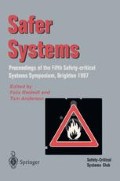Abstract
An effective standard for safety critical software systems is one that should help both developers and assessors of such systems. For developers it should be clear what is required in order to conform to the standard, while for assessors it should be possible to determine objectively compliance to the standard. The existing set of standards do not pass this basic quality test. We provide a framework for improving such standards. We view a standard as a collection of requirements. For each requirement we first identify the process, product, or resource that is the primary focus. Next we consider the clarity of the requirement in respect of the ease with which it is possible to assess conformance to it. We describe guidelines for interpreting requirements to make this task more objective. The method is applied extensively to the IEC 1508 Safety Critical Standard.
Access this chapter
Tax calculation will be finalised at checkout
Purchases are for personal use only
Preview
Unable to display preview. Download preview PDF.
References
Albrecht A.J, Measuring Application Development, Proceedings of IBM Applications Development joint SHARE/GUIDE symposium. Monterey CA, pp 83–92, 1979.
British Standards Institute, Specification for Safety Requirements for Pushchairs, British Standards Institute BS 4792, 1984.
Fenton NE and Pfleeger SL, Software Metrics: A Rigorous and Practical Approach (2nd Edition), International Thomson Computer Press, 1996.
Fenton NE, Littlewood B, and Page S, Evaluating software engineering standards and methods, in Software Engineering: A European Perspective (Ed: Thayer R, McGettrick AD), IEEE Computer Society Press, pp 463--470, 1993.
Fenton NE, Pfleeger SL, Glass R, Science and Substance: A Challenge to Software Engineers, IEEE Software, 11(4), 86–95, July, 1994.
IEC (International Electrotechnical Commission), Software for computers in the application of industrial safety related systems, IEC 65A, 1992.
IEC (International Electrotechnical Commission), Functional safety of electrical/electronic/programmable systems: generic aspects, IEC 1508, 1995.
Ministry of Defence Directorate of Standardization, Interim Defence Standard 00–55: The procurement of safety critical software in defence equipment; Parts 1–2, Kentigem House 65 Brown Street Glasgow, G2 8EX, UK, 1991.
Pfleeger SL, Fenton NE, Page P, Evaluating software engineering standards, IEEE Computer, 27(9), 71–79, Sept, 1994.
Author information
Authors and Affiliations
Editor information
Editors and Affiliations
Rights and permissions
Copyright information
© 1997 Springer-Verlag London Limited
About this paper
Cite this paper
Fenton, N. (1997). How to Improve Safety Critical Systems Standards. In: Redmill, F., Anderson, T. (eds) Safer Systems. Springer, London. https://doi.org/10.1007/978-1-4471-0975-4_6
Download citation
DOI: https://doi.org/10.1007/978-1-4471-0975-4_6
Publisher Name: Springer, London
Print ISBN: 978-3-540-76134-1
Online ISBN: 978-1-4471-0975-4
eBook Packages: Springer Book Archive

